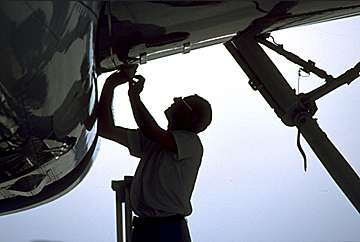Staying Ahead Of Outsourcing and Consolidation Trends In
Commercial Maintenance, Repair and Overhaul
 A struggling airline industry,
ongoing pressure on profits and intensifying competition are
transforming the EUR 8.5 billion European commercial maintenance,
repair and overhaul (MRO) market. The resultant trends toward
outsourcing and industry consolidation are expected to force market
participants to redefine their competitive strategies.
A struggling airline industry,
ongoing pressure on profits and intensifying competition are
transforming the EUR 8.5 billion European commercial maintenance,
repair and overhaul (MRO) market. The resultant trends toward
outsourcing and industry consolidation are expected to force market
participants to redefine their competitive strategies.
Several major, low-cost and regional carriers are today
outsourcing their maintenance work. As airline maintenance units
strive for third-party work due to compulsions of overcapacity,
aggressive competition is expected to result for some of the newly
generated outsourced businesses. Even as the contest between
airline maintenance units and independent MRO companies heats up,
the entry of original equipment manufacturers (OEMs) is expected to
further aggravate competitive pressures.
"Maintenance providers are being challenged to fulfill flexible
short-term contracts and long-term total service packages to grasp
the benefit of the general tendency towards outsourcing," says
Frost & Sullivan Aerospace & Defense Manager Manuel
Magalhaes.
"In particular, MRO providers who are able to provide total
service packages or develop the capability to offer such packages
should be able to gain maintenance contracts from the booming
low-cost carriers sector," he adds.
Passenger-to-freighter conversion is also poised to drive the
European commercial MRO market. Spurred by lower costs of
acquisition and conversion, passenger-to-freighter business is set
to expand. With profit margins typically higher than in established
segments such as airframe maintenance, conversions are set to be an
attractive segment.
The shift towards further use of IT-based integrated
information, process management and logistics systems is also
anticipated to boost the overall capability and general reliability
of MRO services. This, together with macro factors such as a
strengthening economic environment and the growth of air traffic is
expected to positively impact commercial MRO volumes and revenues.
By 2012, the overall market is forecast to generate EUR 11.5
billion.
As the market expands, competition among the trio of commercial
aviation MRO operators -- airline operators, independent service
providers and OEMs -- is set to intensify. Airline maintenance
companies currently account for nearly 60 percent of market share,
followed by independent maintenance companies and OEMs.

Mergers and consolidations are likely to continue as a result of
increasing competition and pressure on profits margins. "MRO
business models of diversification include increasing horizontal
integration through globalization and greater vertical integration
through adding services at all levels of the supply chain,"
comments Magalhaes.
While mergers and acquisitions are anticipated to help market
participants broaden capabilities and offer a total services
solution package, joint ventures are anticipated to provide cost
savings and risk sharing in terms of economies of scale, new market
shares and regional presence.
"The process of consolidation will continue until a leaner, more
efficient MRO operation structure emerges. It is clear that
airlines, MRO providers, OEMs and suppliers will cooperate more
closely and, over time, OEMs will play a more important role,"
remarks Magalhaes.
Resource limitations are expected to restrict the number of
companies that can adapt to these changing dynamics. In the
meantime, MRO providers must design and implement internal
strategies to accommodate external change. High performance in
crucial areas such as turn-around time and quality, flexibility and
technical capability in offering total service solutions as well as
reduced costs to benefit both MRO providers and the airlines will
be central to such strategic initiatives.
 ANN's Daily Aero-Term (05.05.24): Omnidirectional Approach Lighting System
ANN's Daily Aero-Term (05.05.24): Omnidirectional Approach Lighting System Aero-News: Quote of the Day (05.05.24)
Aero-News: Quote of the Day (05.05.24) Airborne 05.06.24: Gone West-Dick Rutan, ICON BK Update, SpaceX EVA Suit
Airborne 05.06.24: Gone West-Dick Rutan, ICON BK Update, SpaceX EVA Suit Airborne 05.03.24: Advanced Powerplant Solutions, PRA Runway Woes, Drone Racing
Airborne 05.03.24: Advanced Powerplant Solutions, PRA Runway Woes, Drone Racing Aero-News: Quote of the Day (05.06xx.24)
Aero-News: Quote of the Day (05.06xx.24)




